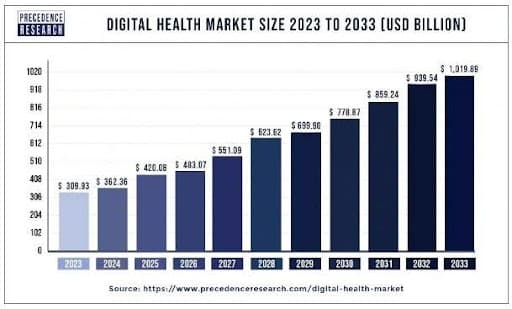The Growth of Digital Health – Exploring the Driving Forces Behind its Expansion
Digital health technology is experiencing a period of unprecedented growth and innovation. The global digital health market is projected to expand from $309B in 2023 to $1,019B by 2032 with a Compound Annual Growth Rate (CAGR) of 12%. Europe is reportedly the largest market, while Asia Pacific is the fastest-growing region. Although many factors contribute to this significant market growth, advancements in robotics, artificial intelligence, and remote monitoring devices stand out as primary driving forces.
So what is Digital Health Technology (DHT), and why has it become a vital part of our day-to-day life? The U.S. Food and Drug Administration (FDA) defines DHTs as
“systems that use computing platforms, connectivity, software, and/or sensors
for healthcare and related uses.”
The FDA further provides several specific categories and terms for discussing the variety of Digital Health technologies, services, and products.
- Software as a Medical Device (SaMD) – Software intended for one or more medical uses that may run on different operating systems or in virtual environments. Software run on a hardware medical device is a SaMD when not part of the intended use of the hardware medical device. Software is not SaMD if it drives or controls the hardware medical device. A smartphone microphone that detects interrupted breathing during sleep and wakes the sleeper is an example of a SaMD.
- Artificial Intelligence and Machine Learning (AI/ML) in Software as a Medical Device - A device or product that can imitate intelligent behavior or mimic human learning and reasoning. Artificial intelligence includes machine learning, neural networks, and natural language processing. Some terms that describe artificial intelligence include computer-aided detection/diagnosis, statistical learning, deep learning, or smart algorithms. A device that estimates the probability of acute cardiac ischemia (ACI) is an example of AI/ML.
- Cybersecurity - A device or product that can prevent unauthorized access, modification, misuse, denial of use, or the unauthorized use of information stored, accessed, or transferred from a medical device to an external recipient. Limiting access through users' authentication is an example of cybersecurity use in digital devices.
- Device Software Functions, including Mobile Medical Applications (MMA) - A software function that meets the definition of a medical device. An attachment to a mobile platform that measures blood oxygen saturation is an example of a device software function via a mobile medical app.
- Health IT – Health information technology is a broad concept encompassing various technologies. Health IT uses computer hardware, software, or infrastructure to record, store, protect, and retrieve clinical, administrative, or financial information. Examples include electronic health records.
- Medical Device Data System (MDDS) - Hardware or software that can transfer, store, convert data formats, or display medical device data without controlling or altering the functions or parameters of any connected medical device. An EKG that stores previous patient data results for comparison is an example of an MDDS.
- Medical Device Interoperability - Medical device interoperability is the ability to safely, securely, and effectively exchange and use information among one or more devices, products, technologies, or systems.
- Telemedicine/Telehealth - Telehealth uses electronic information and telecommunications technologies to support and promote long-distance clinical health care, patient and professional health-related education, public health, and health administration. Examples include videoconferencing, the internet, store and forward imaging, streaming media, and terrestrial and wireless communications.
- Wireless Medical Devices - A device or product that uses wireless communication of any form (Wi-Fi, Bluetooth, Near Field Communication (NFC)) to perform at least one function.
DHTs have become a crucial component of the healthcare industry. From telemedicine and wearable devices to health apps and artificial intelligence, digital health innovation transforms how healthcare is accessed, delivered, and experienced. Ongoing improvements focus on developing and enhancing accuracy, user experience, and integration into digital healthcare platforms.
Consumer Expectations
Technology is not the only driver in the growth of digital health. The expectations and behaviors of consumers have significantly increased. Today's consumers, including healthcare professionals, technology enthusiasts, policymakers, and individuals interested in healthcare innovation, seek convenience, accessibility, and personalized experiences in all aspects of their lives, including healthcare. Digital health solutions are fulfilling these preferences by offering on-demand access to healthcare services, remote monitoring capabilities, and virtual consultations.
The COVID-19 pandemic has not just accelerated the need for telehealth and virtual care but has underscored the importance of digital health in overcoming barriers to the traditional healthcare structure. The U.S. Government Accountability Office (GAO) studied Medicaid customers in five states. Telehealth services skyrocketed from the pre-pandemic level of 2.1 million to a staggering 32.5 million from March 2020 to February 2021. This rapid shift is a testament to digital health technology's crucial role in our lives and its potential to reshape the future of healthcare.
Technological Advancements
Technological advancements and increased access to these products have made digital health options possible. Breakthroughs in mobile connectivity, cloud computing, big data analytics, and artificial intelligence have allowed for innovative and sophisticated solutions. Mobile health applications, remote patient monitoring devices, and predictive analytics tools are examples of how technology is driving the digital health requirements of healthcare by enabling more personalized, efficient, and data-driven approaches to wellness and disease management.
Change in Consumer Needs
Preference for more personalized medicine is not the end of the story. Modern growth in chronic diseases, geographical limitations, aging populations, and rising healthcare costs have also intensified the need to address healthcare challenges with innovative technologies. For example, recent reports have highlighted critical healthcare staffing shortages, with the World Health Organization (WHO) indicating that there will be a shortage of 15 million medical personnel worldwide by 2030.
Digital health may help fill gaps in healthcare worker shortages by improving remote access and patient engagement while encouraging preventive and proactive approaches to health management. By offering individuals alternative options, digital health can provide individuals with more treatment choices. Simultaneously, healthcare providers can deliver patient-centered care more effectively and efficiently, serving a more geographically expansive patient base.
Potential Challenges of DHTs
Although there are many advantages to the growth of the digital health industry, so are the potential barriers and challenges. With the increase in electronically transmitted data sharing, the risk of cyberattacks and data breaches has grown. Without necessary and costly infrastructure, these breaches may lead to disruption in service and theft of sensitive information. Additionally, the financial investment required to create the appropriate security systems can hinder small and startup businesses' growth. Some technologies, such as artificial intelligence (AI), may also present novel ethical concerns with respect to patient consent, unanticipated algorithmic bias, and delegated decision-making. At a more basic level, product training and education and the adoption of new technologies, both by consumers and medical professionals, can be a significant hurdle. Product and service developers and industry regulators must consider all these challenges as new DHTs are designed and marketed.
Regulatory Oversight
The FDA formed the Digital Health Advisory Committee in 2024. The committee will focus on artificial intelligence, machine learning, and virtual reality and advise the FDA on the risks, benefits, and clinical outcomes linked to these technological advancements, including insights and potential barriers to the healthcare system. In short, the committee aims to ensure that digital health innovations are safe and effective and that patient-generated health data is adequately protected.
The accelerated growth of digital health represents a shift in healthcare delivery and holds promise for transforming the future of medicine. By harnessing powerful technology, addressing evolving consumer needs, fostering regulatory support, and prioritizing improved healthcare outcomes, digital health can revolutionize healthcare delivery and usher in a new era of personalized, accessible, and effective healthcare products and services.
Authored by Maria-Cristina Smith, Berkley Life Sciences, AVP, Products & Professional Liability Specialist




